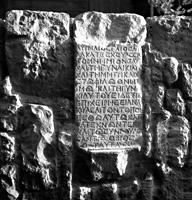 MAMA XI 39 (Eumeneia)
MAMA XI 39 (Eumeneia) 
Funerary bomos of Aurelius Gaius and family and friends
- Type of monument:
- Funerary bomos.
- Location:
- Işıklı (Eumeneia): in the wall of a house in the southern part of the village.
- Description:
- Marble bomos, complete; upper and lower mouldings damaged, and chipped at left.
- Dimensions:
- Ht. 0.59; W. 0.23+ (shaft); Th. --; letters --.
- Record:
- WMC notebook copy; photograph (1954/9).
- Publication:
- Paris 1884: 233-4, no. 1; Ramsay, Phrygia II 385, no. 231; (Frey 1952: 761; Sheppard 1979: 174-5; Trebilco 1991: 70, no. 4.3; IJO II, p.394 n. 148).
- Date:
- Third century AD.
Αὐρήλιος Γάϊος Ἀπ[ελ]-
λᾶ κατεσκεύασεν
τὸ μνημῖον ἑαυ[τῷ]
καὶ τῇ γυναικὶ αὐτ̣[οῦ]
5καὶ τῇ μητρὶ καὶ χ[ρη]-
στῷ φίλῳ Ὀνησ-
ίμῳ καὶ τῇ γυνα[ι]-
κὶ αὐτοῦ· εἰ δέ τις
ἐπιχειρήσει ἀνα[σ]-
10κευάσαι τὸν τόπον,
ἔσθω αὐτῷ κατ[ά]-
ρα τέκνων τέκν[α]
καὶ τῷ συνβουλε[ύ]-
σαντι. hed. ὁ βίος
15 hed. ταῦτα. hed.
Aurelius Gaius, son of Apellas, constructed the memorial for himself and his wife and his mother and his excellent friend Onesimos and his wife; if anyone tries to dismantle the grave-plot, may there be a curse on him, to his children’s children, and on him who counsels it. Such is life.




A place in Gaius’ tomb is reserved for his friend Onesimos and his wife (Robert, Hellenica XI/XII, 423 n.3). For this phenomenon at Eumeneia, compare the Christian epitaph IGR IV 731 (Robert 1963: 361-5), in which Aur. Nikeros reserves a place in his tomb for his friend Aur. Mannos, a Christian horse-archer from Edessa (ἔθηκα δέ φίλον· ἐνθάδε κεκήδευτε Αὐρ Μάννος κτλ.). In MAMA IV 343, the weaver Attalos sets up a gravestone for his friend Iulius; in Drew-Bear 1978: 97-8, IV 34 (SEG 28, 1125), Severus Argentis admits the cabbage-seller Theodotos to his tomb. Cf. also MAMA IV 358 (Aur. Agapomenos and Aur. Artemidoros); MAMA XI 36 (1954/14).
The verb ἀνασκευάσαι (lines 9-10) is very rare in this context; see also TAM IV 1, 376 (Nikomedeia: Robert, Hellenica XI/XII, 386-92). On the curse-formula in lines 11-12 (frequently, but not invariably, Jewish), see Robert, Hellenica XI/XII, 390; Robert, OMS V, 738-9; Trebilco 1991: 69-74; Strubbe 1994: 73-83; Strubbe 1997: 197-8, no. 290; IJO II, pp. 346-7, 394. For the concluding formula ὁ βιὸς ταῦτα, ‘such is life’ (lines 14-15), see Robert, Hellenica XI/XII, 426 n.5; Hellenica 13, 185-6, 272-3; OMS V, 328.